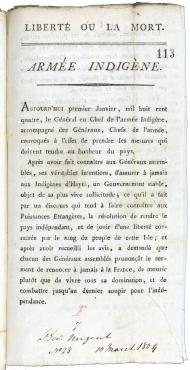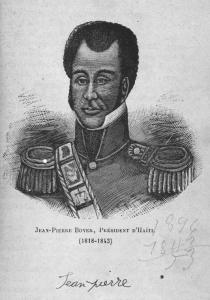Whoever called Paris the city of light definitely wasn’t here on a wet Friday in December like today. You felt you were barely able to wake up. In the subterranean depths of the National Library, I time travelled to 1826 when France imposed an indemnity on Haiti for having declared itself independent. And from those old papers you could begin to sense how the free republic tweaked the nose of the old slavers and monarchists. You could also perceive how the modern debt system was from its beginnings a racialized tool of domination.
Haiti became free in 1804. There’s a few documents available that record the moment, like this text of the declaration of independence:
France did not recognize the new Republic and continued to hope that it might regain its old colony. By 1826, it was clear that this would never happen. Haitians had been free for a generation and what one French colonist called “the magic of slavery” no longer worked.
In return for accepting Haiti’s independence, France demanded an indemnity of 150 million livres, the old monarchist money. However, the true believers in colonial slavery were incensed. They valued their property in the former Saint-Domingue, including human property, at no less than four billion livres so this sum seemed derisory. A pamphlet and newspaper war began, sounding for all the world like Fox News, declaring that a war could easily be won in Haiti, slavery restored and the plantations reopened.
There are dozens of such documents in the National Library. They tell another story as well, one of the post-revolutionary debts of the old slavers, unable to get their hands on the indemnity because their creditors claimed it first or because bailiffs intervened.
Against that, there’s so little from Haiti but what remains is eloquent in its own way. Haiti passed a law in February 1826 accepting the indemnity as a national debt. There are two clauses to the law, which I was able to read today. Above was Haiti’s new coat of arms, which displayed powerful cannon suggesting that the country would defend its motto “Liberty or Death,” and replaced the fetishized cash crops, like sugar and coffee, with a splendid palm tree.
The law declared:
Article One
The indemnity of 150 million pounds consented to France in exchange for the full and entire recognition of the independence of Haiti, is recognized as national debt
Art II
The President of Haiti will take measures which his wisdom will suggest to him to liberate the nation from this debt.
So although the French portrayed the indemnity as compensation for the wrongful abolition of slavery, the Haitians presented it as a contractual exchange for the full and entire recognition of their independence.
And where the French law required an extensive 27 member commission to decide what to do with the indemnity, Haiti devoted one line to the not very important question of repayment. In the first year, they borrowed the money from France to repay to France. For the next two years nothing was repaid. French royalists worried out loud about the possibility that they might refuse to pay it.
Working on that fear, President Boyer (below) had the indemnity reduced to 90 million.
But it was not all détournement and bluff. To repay the debt, Boyer had to establish a national bank of Haiti in 1826 and he compelled the subalterns to do forced labor to raise money.
But the implied leisure of Haiti’s emblem, the palm tree, was not lost on the colonists. The racist diatribes in 1826 against the formerly enslaved, accusing them of living in “indolence,” doing nothing but dance the bamboula, sleep in the sun, and eat tropical fruit prefigures both Carlyle’s widely-cited discourse against the emancipated of 1846–and of course the much desired “holiday in paradise” now sold to Northerners. What an irony: the tropical island depends for its hard currency on the former slave owners’ fantasy of the life of liberated slaves.
At Bowdoin College that same year of 1826, the second African-American to graduate from college gave the commencement address about Haiti. John B. Russwurm did not mention the debt. He was jubilant:
Can we conceive of anything which can cheer the desponding spirit, can reanimate and stimulate it to put everything to the hazard? Liberty can do this. Such were its effects upon the Haitians—men who in slavery showed neither spirit nor genius: but when Liberty, when once Freedom struck their astonished ears, they became new creatures, stepped forth as men, and showed to the world, that though slavery may benumb, it cannot entirely destroy our faculties. Such men were Toussaint L’Ouverture, Desalines and Christophe!
Such jubilant theory was exactly what the former colonists feared. They thought it meant the end of slavery and the Caribbean colonies and it did. Boyer thought he could turn the debt to his advantage and not overly burden his new nation in so doing. If he did not succeed in doing so, it was largely because the new imperialist era of the nineteenth century saw exactly what a threat Haiti had become.



It is a very interesting post Nicholas! That made me think of a similar situation in the spanish context. And that brought me to the Spanish-Moroccan War, known in Spain as “La Guerra de África” (African War, 1859-1860), in the last spanish colonial period. In this war Spain tried to protect the two spanish cities in the north coast of Morocco, Ceuta and Melilla, that were being attack by the moroccan (or at least this was the official version). During the war Spain conquered the city of Tetuán. The war ended with the treaty of Wad-Ras (April 1860) that gave the victory to Spain and between the agreements the Sultan of Morocco had to paid 100 millions of the old “pesetas” to Spain. Although the payment of the compensation (can be say debt?) created enormous financial difficulties to Morocco, the compensation was finally paid, so Tetuan was returned on May 2,1862.
PS: Sorry for my english.
Javier Cuevas, University of Málaga.
Now that’s what I call a comment, Martin. Wow.
Alternative art schools
The Cedilla that smiles
By: Martin Patrick
From September 1965 to October 1968, the Fluxus artists Robert Filliou and George Brecht conducted a modest yet highly significant art-life experiment, by collaboratively establishing a shop called La Cédille qui sourit (The Cedilla that smiles) in Villefranche-sur-Mer, a fishing village near Nice. Within its confines, the ‘non-boutique’ included among its wares Fluxus multiples and other small works. But it was generally closed, and the artists, along with their co-conspirators, might frequently be found elsewhere, such as in neighbouring cafés, befitting Filliou’s belief in the ‘café genius’.
Filliou and Brecht sought to create an International Centre of Permanent Creation which included such eminently purposeless activities as writing letters and poems, inventing games, telling jokes. In 1966 they created the Non-School of Villefranche and when they proposed relocating to the town’s 13th-century citadel, the mayor didn’t reciprocate their interest. The school actually didn’t advance far past their loose yet inspiring motto: ‘A carefree exchange of information and experience. No students, no teachers. Perfect licence, at times to listen at times to talk. Some of their projects were collected in a 1967 volume Games at the Cedilla.
As to the question of what the Cedilla amounted to exactly, in retrospect it seemed to simultaneously fulfill and thwart manifold definitions: a shop that wasn’t a proper shop, a self-declared school which was adamantly non-institutional, and a performative artwork confounding many traditional aesthetic notions.
Predating by decades such contemporary art/pedagogical initiatives as the Mountain Bar, United Nations Plaza, or 16 Beaver Group, La Cédille did not exhibit either major connections with the art market or any major ideological or activist stance yet it nonetheless facilitated a quasi-utopian microworld of activity, consistent with so many of Filliou’s other dialogical and collaborative projects. Filliou and Brecht’s efforts served to disrupt entrenched hierarchical patterns of artist/audience, institution/public, art/life and teacher/student.
A Zen adept, Filliou used the characteristic model of posing opposites to show the unlikely connections between all things, and his research was often stated in counter-intuitive fashion: ‘Creation becomes very easily for me recreation. Search – I search for happiness and joy – becomes research.’ When $30 rent became unsustainable, the Cedilla’s work as play continued in other versions, such as via Filliou’s itinerant Volkswagon bus – the Genial Republic – which deposited the artist at Amsterdam’s Stedelijk Museum for a one-month residency in late 1971.
Themes central to Filliou’s work harbour relevance for the current moment: questioning the economies of art, interrogating ecological life patterns, seeking empathic dialogue with others. Filliou’s background offered a rather unusual path towards these notions: born in France, as a teenager he was involved in the French resistance, he later travelled to the United States, after working mundane jobs he eventually completed his degree in economics, and not long after defected to artmaking. If there are helpful models to be derived from Filliou’s legacy today, they might include the capacity to incorporate liveliness, playfulness, and a joyful spirit into one’s responses to politically charged times that unfortunately tend to appear all too foreboding, perilous, and unsure.
Martin Patrick
Martin Patrick is a Senior Lecturer in Fine Arts at Massey University in Wellington, New Zealand.